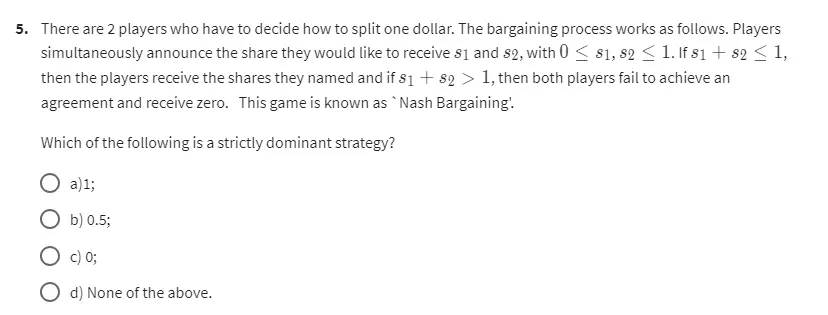Homework Help: Questions and Answers: There are 2 players who have to decide how to split one dollar The bargaining process works as follows. Players simultaneously announce the share they would like to receive s1 and s2, with 0≤s1, s2≤1. If s1+s2≤1, then the players receive the shares they named and if s1+s2>1, then both players fail to achieve an agreement and receive zero. This game is known as ‘Nash Bargaining‘.

Which of the following is a strictly dominant strategy?
a) 1
b) 0.5
c) 0
d) None of the above.
Answer
First, let’s understand the question:
- There are two players, each choosing how much of a dollar they want to receive, denoted by s1s_1s1 for player 1 and s2s_2s2 for player 2.
- The players will get their chosen shares s1s_1s1 and s2s_2s2 if the total s1+s2≤1
- If s1+s2>1, both players get nothing (0).
- A strictly dominant strategy is a strategy that gives a better payoff for a player regardless of what the other player does.
Key Insights:
- If a player chooses s1=1, they are demanding the whole dollar. However, if the other player also chooses any positive s2, the total s1+s2>1, and both get nothing.
- If a player chooses s1=0.5, this might work out if the other player also chooses 0.5 because 0.5+0.5=1, so both players would get their shares. But if the other player chooses anything above 0.5, the total exceeds 1, and both get zero.
- If a player chooses s1=0, they are guaranteed to receive nothing, but the other player can choose any share s2≤1, ensuring at least one player gets something.
Given Options: Step by Step Answering
a) Choosing s1=1:
- If player 1 chooses 1, and player 2 chooses anything positive, both get 0 because s1+s2>1.
- This is not a dominant strategy because it can result in both players getting zero.
b) Choosing s1=0.5:
- If both players choose 0.5, they both get their chosen share.
- However, if the other player chooses something larger than 0.5, both get zero.
- This is not strictly dominant because it doesn’t always give a better payoff regardless of what the other player does.
c) Choosing s1=0:
- If player 1 chooses 0, they receive nothing, but the other player can choose anything s2≤1, meaning player 1 doesn’t influence the outcome.
- This is also not strictly dominant since it guarantees zero payoff for player 1, regardless of what the other player does.
Final Answer:
There is no strictly dominant strategy in this game because none of the choices 1, 0.5, or 0 guarantee a better payoff for a player regardless of what the other player chooses.
Thus, the correct answer is: d) None of the above.
Learn More: Homework Help
Q. Why were low-quality videos so often used when Internet connections were poorer than they are today?
Q. Which one links computers to a base computer making it possible to share software materials?
Q. What might be a common cause for the error “Unable to verify the game session”?